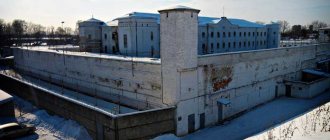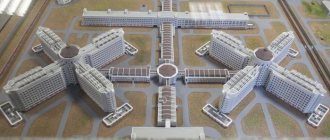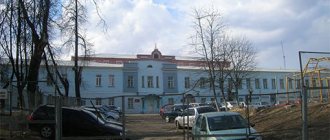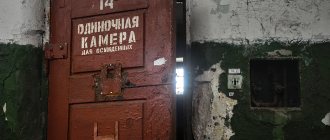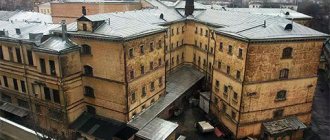Author: KombrigMeNeKolun
15 June 2021 19:30
Tags: pre-trial detention center stories photos
5930
38
Today the penal system consists of: 762 correctional colonies, 198 pre-trial detention centers, 8 prisons and 62 juvenile colonies. Many operating Russian pre-trial detention centers are located in historical buildings erected in the 19th century and earlier.
0
See all photos in the gallery
Cheboksary prison (FKU pre-trial detention center No. 1 of the Federal Penitentiary Service for the Chuvash Republic).
0
×
0
Year of foundation: 1648; Capacity - 212 seats; The regime building that has survived to this day was erected on the site of a burnt wooden fort, built by personal order of Tsar Ivan IV the Terrible. There is an urban legend that an underground passage supposedly runs from the walls of the institution, filled in in the 20th century. There are no known cases of successful escape from this prison; Famous prisoners are, according to legend, brothers Stepan and Frol Razin.
Sailor's silence
0
The third most “popular” prison in Moscow, located on Matrosskaya Tishina Street and which gained all-Russian fame in the 90s, is where Sergei Mavrodi, a man whose fate literally the entire population of Russia was gritting their teeth, was serving his sentence. Prison old-timers say that Mavrodi sat here for so long that his ghost still wanders the corridors of the prison.
0
Infrastructure: 3 secure buildings containing more than 2,000 prisoners.
Bogatyanovskaya prison (FKU pre-trial detention center No. 1 of the Federal Penitentiary Service for the Rostov region).
0
0
Year of foundation: 1768; Capacity - 1000 seats; The prison building was built by decree of Empress Catherine II in the shape of the letter “E”. At the time of construction it was one of the most modern prisons in Russia. Rebuilt in 1943 after the liberation of the city from the Nazi invaders. In the Soviet criminal environment, prison was considered one of the strictest and most cruel; Famous prisoners - Andrei Chikatilo, Yuri Budanov.
Belevsky prison castle (FKU pre-trial detention center No. 3 of the Federal Penitentiary Service for the Tula region).
0
0
Year of foundation: 1768; Capacity - 78 seats; Built on the site of a city fortress founded in the 16th century, the thickness of the walls of the chambers reaches 1 meter. According to legend, the prisoners once saved the city during a fire - they broke into a burning powder warehouse and lowered barrels of gunpowder into the Oka River. During the repressions of the 1930s. clergy of the Russian Orthodox Church were kept in prison.
Butyrka (FKU pre-trial detention center No. 2 of the Federal Penitentiary Service for Moscow).
0
0
Year of foundation: 1771; Capacity - 2700 seats; It was erected according to the design of the architect Matvey Kazakov on the site of a soldier's castle-fortress. It was used as the central prison of Moscow and as the largest transit point in the Russian Empire. In 1908, the famous illusionist Harry Houdini, performing in Butyrka, took 28 minutes. got out of the “transport box” for prisoners; Famous prisoners - Emelyan Pugachev, Vladimir Mayakovsky, Felix Dzerzhinsky, Nestor Makhno, Osip Mandelstam, Sergei Korolev, Varlam Shalamov, Alexander Solzhenitsyn, Sergei Mavrodi.
Butyrka prison
Perhaps one of the most famous Russian prisons, founded in 1771. The largest prison in the Russian capital, and the building itself is included in the list of architectural monuments.
After the Bolsheviks came to power, it was transformed into a transit prison, and during the period of Stalinist repressions there were up to 170 people in one cell. Among the celebrities sitting here were Varlam Shalamov, designer Sergei Korolev, and Nobel Prize laureate Alexander Solzhenitsyn.
History has also recorded the famous escapes from Butyrka. In 1996, the first female escape occurred when 26-year-old Natalya Sorokozherdeva managed to escape the security perimeter.
5
Vladimir Central (FKU T-2 Federal Penitentiary Service for the Vladimir Region).
0
0
Year of foundation: 1783; Capacity - 1220 seats; Built by decree of Empress Catherine II as a “workhouse” for petty thieves, in 1906 it became a central prison - a particularly fortified place of imprisonment with strict internal regulations. In the 1950s in solitary confinement there were “nameless” prisoners kept under numbers (relatives of Joseph Stalin, former leaders of the Baltic countries). Currently a maximum security prison; Famous prisoners - Mikhail Frunze, Vasily Stalin, Francis Gary Powers, Janos Kadar, Vladimir Bukovsky.
Life sentence and no sweets
Each cell in Snezhinka is designed for four places, but so far there are only two people in them: there are not too many convicts in IK-6. Every day of prisoners is built according to a clear schedule: wake up at 6:00, bedtime at 22:00. Twice a week, prisoners can shower for 15 minutes. In their free time from work and walking, they can read, play chess or checkers, and also watch TV. Once a week, a movie show is held at Snezhinka.
Prisoners in IK-6 are fed three times a day; their diet consists of porridge, borscht, naval pasta, fish and stewed vegetables. Repeating the same dish is allowed no more than three times a week. Each prisoner in Snezhinka receives 90 grams of meat daily. Working in the kitchen and distributing food are 47 convicts convicted of petty crimes, who were specially brought to IK-6.
“Snezhinki” does not feed convicts sweets, but prisoners can order them themselves in the colony store. At the same time, each prisoner has a limit on purchases. For the first ten years of the term, it is a maximum of six thousand rubles, and then increases by another thousand. After 20 years behind bars, a convicted person can already spend 7.5 thousand rubles a month on purchases - of course, if he has this money.
Lunch at IK-6 “Snezhinka”: first course, two second courses and compote.
Photo: Evgeny Pereverzev / Kommersant
Two decades behind bars provide another privilege - additional visits with relatives. If until 20 years of imprisonment, each prisoner is entitled to two short-term and two long-term meetings per year, then after 20 years, convicts receive the right to three visits with loved ones for four hours and three meetings lasting up to three days.
However, all this is only due to those convicts whose behavior the prison administration has no complaints about. Violators may not only be denied visits, but also sent to a punishment cell (punishment cell) for up to 60 days, or even transferred to a particularly strict prison regime. Convicts can stay there for up to three years.
The cells for repeat offenders are special: instead of ordinary beds, prisoners sleep in them on not very comfortable sun loungers, which are removed during the day and fastened to the wall. The convicts there are not entitled to any parcels, visits, or watching TV. However, so far there has not been a single prisoner in Snezhinka who would be thrown into a punishment cell for violations.
Stary Oskol Prison (FKU Pre-trial Detention Center No. 2 of the Federal Penitentiary Service for the Belgorod Region).
0
Year of foundation: 1795; Capacity - 275 seats; It is located in the government building, erected by decree of Empress Catherine II, one of the oldest stone buildings in the city. Initially, the city treasury, a guardhouse with prison cells, wine warehouses, a zemstvo court, an archive and the mayor’s apartment were located there. The building was rebuilt many times, and by 1862 it was completely turned into a prison. In 1967 it was converted into a pre-trial detention center.
Pskov prison castle (FKU pre-trial detention center No. 1 of the Federal Penitentiary Service for the Pskov region).
0
0
Year of foundation: 1805; Capacity - 377 seats; Built according to a standard design for a government building by architect Andreyan Zakharov on the site of a wooden fort, expanded in 1869, and built on in 1888. The regime of detention was quite strict - prisoners were forbidden to have ink, pencils and paper in their cells. Currently, like a significant part of similar institutions, it is a pre-trial detention center.
Civil Prison (FKU Pre-trial Detention Center No. 2 of the Federal Penitentiary Service for the Chuvash Republic).
0
Year of foundation: 1809; Capacity - 312 seats; The historical building was built on the site of a wooden prison that was part of a military fortress; According to local legend, when Catherine II was traveling from Cheboksary to Kazan via Tsivilsk, a boy threw a stone at her carriage. The Empress ordered to find the hooligan and put him in prison - so the boy became the youngest prisoner. Today, correctional institutions (pre-trial detention centers and two colonies) are actually the city-forming institutions for Tsivilsk.
Work more - break less
Official representatives of the FSIN and members of the Public Observatory Control (POC, which has prison system institutions in each region) often have different data on the process of humanization taking place in Russian prisons, pre-trial detention centers and colonies.
The position of the Federal Penitentiary Service is that every year the conditions of detention of Russian prisoners are improving and approaching European standards. This especially concerns the occupancy of prison cells. In many “covers” today it is even less than the norm.
The famous Vladimir Central, according to the Federal Penitentiary Service of the Vladimir Region, today is more comfortable in terms of living conditions: the cells on the windows no longer have “eyelashes” (iron blinds), the premises are equipped with televisions, refrigerators and radios. In 2003, in the Vladimir Central Prison, they were the first in the FSIN system to open a Legal Information Center for convicts.
In almost all Russian prisons, the production of products sold outside the “cover” has been established - the Federal Penitentiary Service considers occupational therapy in custody to be an important factor in the law-abiding behavior of prisoners. In the Vladimir Central they make souvenirs with the symbol of the “lid”, they sell well. In the Verkhneuralsk prison they sew work clothes, in Minusinsk they produce building materials. Most Russian prisons have subsidiary farms where convicts grow agricultural products and raise livestock - from chickens to cows.
Yaroslavl Central (FKU pre-trial detention center No. 1 of the Federal Penitentiary Service for the Yaroslavl region).
0
0
Year of foundation: 1810; Capacity - 1000 seats; The prison was erected in Korovnitskaya Sloboda at the suggestion of Yaroslavl Governor-General Alexei Melgunov. It served as a transit point for prisoners being transferred to Siberia. After the revolution, participants in peasant uprisings, counter-revolutionaries, and hierarchs of the Russian Orthodox Church were kept in "Korovniki". Since 1964 - regional detention center; Famous prisoners are former Minister of War of the Provisional Government Alexander Verkhovsky, security officer Vyacheslav Menzhinsky, common-law wife of Admiral Kolchak Anna Timireva.
Minusinsk prison (FKU Prison of the Federal Penitentiary Service for the Krasnoyarsk Territory).
0
0
Year of foundation: 1823; Capacity - 1000 seats; One of the oldest and largest penitentiary institutions in Siberia. Built as a transit prison for prisoners sentenced to exile; The stone building was completed in 1912. In Soviet times, it became an “executive” prison - death sentences were carried out on the territory of the prison. Currently, persons who have committed particularly serious crimes and terrorist attacks, repeat offenders, as well as leaders of criminal communities are serving their sentences here; Famous prisoners are the Decembrists Vasily Davydov, Nikolai and Pavel Bobrishchev-Pushkin, and the revolutionary Yuli Martov (Zederbaum).
White Swan
This is one of the most strict correctional institutions in Russia. Life here for prisoners is, to put it mildly, not sweet. True, we can say that it serves us right. After all, the inhabitants of the White Swan (Solikamsk colony) are murderers, rapists and others serving life sentences. The prison was founded in 1938. There are several options why the colony is popularly called the White Swan. The first of them is an option with images of white swans installed on the territory. The second is an analogy with how prisoners move around the territory of the colony - in the “swan” pose, i.e. bending at 90 degrees and raising his handcuffed hands high. On the territory of this prison there are practically no concepts of authority and “cool”. Character and health are destroyed instantly here. The famous field commander of the Chechen gang formations, Salman Raduev, was convinced of this the hard way. He lived in the White Swan for only a few months, after which he died under mysterious circumstances.
Ekaterinburg Central (FKU pre-trial detention center No. 1 of the Federal Penitentiary Service for the Sverdlovsk Region).
0
0
Year of foundation: 1830; Capacity - 1800 seats; The prison castle was erected according to the design of the architect Mikhail Malakhov, one of the authors of St. Isaac's Cathedral in St. Petersburg. In Soviet times - one of four "executive" prisons - with death rows and a place for executions. In 1945-1954. several solitary confinement cells housed Nazi criminals; Famous prisoners include Yakov Sverdlov, personal adjutant of Hitler Otto Günsche.
Map of prisons and colonies in Russia
Modern information retrieval systems allow you to find Russian prisons on the map. To do this, you can use a ready-made map:
It is also possible to find the necessary institution using a map that provides information in real time. To do this, you need to go to the website of one of the major Internet search engines in the maps section.
Oryol Central (FKU pre-trial detention center No. 1 of the Federal Penitentiary Service for the Oryol region).
0
0
Year of foundation: 1840; Capacity - 200 seats; The prison company building is one of the oldest in the city. In 1908, one of the largest convict prisons in Tsarist Russia was built on its basis, which was distinguished by very harsh conditions for prisoners. During the Great Patriotic War, the Germans turned the prison into a concentration camp for partisans. Today it is a regional detention center and prison hospital for patients with tuberculosis; Famous prisoners - Felix Dzerzhinsky, Grigory Kotovsky.
Eletskaya cover
The prison is located in the city of Yelets, Lipetsk region (Proletarskaya St., 1B, tel.: 8 (47467) 71847.
The buildings on the territory of the present Yeletskaya krytka were used as a prison back in the 16th century. Then they were simply holes dug in the ground, covered with boards on top. A stone building with prison cells appeared here in 1830.
Why is it considered one of the most terrible?
In the old days there were unbearable conditions here. Prisoners were chained to the wall for any offense and kept in cells without light or food. There was a high mortality rate in prison. Also, quite a few prisoners went crazy.
Today, Yeletskaya Krytka remains one of the most terrible prisons in Russia. All newcomers are placed in cells with “experienced” prisoners, whose goal is to intimidate the new arrivals.
There are many rumors about facts of violence against prisoners in this prison, including from the administration.
Who gets here?
About 80% of prisoners in this penal colony are serving time for murder.
Among the famous prisoners:
- Thief in law Vitalik Tbilissky.
- Tariel Oniani, also a thief in law and leader of the Kutaisi organized crime group.
- Thief in law from Chechnya Akhmed Shalinsky.
The list of such people in Yelets prison can be continued for a long time.
Krasnoyarsk prison (FKU pre-trial detention center No. 1 of the Federal Penitentiary Service for the Krasnoyarsk Territory).
0
0
Year of foundation: 1850; Capacity - 1500 seats; Because of the color of the walls, the stone building of the prison castle received the nickname “White Swan” in the city (not to be confused with the colony for life prisoners in Solikamsk, Perm Territory, the pre-trial detention center of Pyatigorsk and Veliky Novgorod). The transit prison was expanded and rebuilt several times. In the 1970s turned into a pre-trial detention center. In 2006, a new building was put into operation; in 2015, the detention center won the FSIN competition for the best correctional institution in Russia; Famous prisoners - Joseph Stalin, Yakov Sverdlov, Georgy Zhzhenov, Ariadna Efron, Alexander Maslyakov.
Crosses
The St. Petersburg “Crosses” also stand out for their strict content. They were founded in 1892, and in 2021 the prisoners were transferred to new buildings located in Kolpino. The uniqueness is that there are covered passages between the buildings with cameras.
Looking at the Old Crosses, it is difficult to imagine that this is a place where prisoners are kept. The beautiful red brick building looks more like an architectural monument. The cells remember their famous inmates, among whom were Marshal Konstantin Rokossovsky, actor Georgy Zhzhenov, and poetess Anna Akhmatova stood in lines for hours to see her son.
There have been three famous escapes throughout history. The most resonant was the escape of Lyonka Panteleev in 1922.
8
Kashinskaya prison (FKU pre-trial detention center No. 2 of the Federal Penitentiary Service for the Tver region).
0
0
Year of foundation: 1855; Capacity - 139 seats; It was built on the site of a wooden prison that had fallen into disrepair, which had existed since the city’s inception. It was distinguished by strict conditions; From 1953 to 1961, those sentenced to 25 years in prison served their sentences in prison. Today it is used as a detention center; Famous prisoners are members of the State Emergency Committee.
Further development of the Russian penitentiary system
During the liberalization of the penal system, Russia got rid of the forced labor camps of the Gulag system. Despite the stable and not exceeding the norm filling of correctional colonies, there is a serious shortage of pre-trial detention centers in the country, which is why even many old prisons (Butyrka, Matrosskaya Tishina) have been converted into pre-trial detention centers.
Perm-36 is the last forced labor camp, where until recently there was a memorial museum
Another serious problem is the treatment of prisoners in prisons. FSIN employees are often accused of exceeding their official powers, and information about beatings and torture is repeatedly leaked from the colonies. The Russian penitentiary system provides virtually no further support for the prisoner after his release - this is the main stumbling block on the path to a fair prison system.
In many countries, especially in Europe, they are gradually moving towards the concept of a prison in which neither psychological nor physical pressure will be exerted on the offender. These institutions are more reminiscent of health camps with hotel-type rooms equipped with the latest technology, despite the fact that murderers, maniacs and extremists are serving their sentences there. These countries show a gradual decline in crime rates and incarceration rates per capita. It is possible that if this approach is experimentally applied in Russia and in our country, the number of crimes and especially recidivism will decrease.
Chistopol prison (FKU pre-trial detention center No. 5 of the Federal Penitentiary Service for the Republic of Tatarstan).
0
0
Year of foundation: 1856; Capacity - 200 seats; Built as a transit facility, after the October Revolution of 1917 it came under the control of the NKVD; foreigners and especially dangerous political criminals were kept in the prison. Before the 1980 Olympics, a significant portion of prisoners from the cities of the Golden Ring of Russia were transferred here. Since 2005 - pre-trial detention center.
Federal state prison-type institutions
Citizens of Russia can obtain general information about prison-type institutions located within the state. The most famous are the following objects:
| No. 1 Federal Penitentiary Service for the Vladimir Region | ||||
| Index | Address | Modes | Contacts | |
| 600120 | Vladimir region, Petushinsky district, Pokrov, st. October Revolution, 75-A | General Strict | 8 (49243) 6-72-70 | |
| In the Vladimir region (Vladimir Central) | |||
| Index | Address | Mode | Contacts |
| 600020 | Vladimir region, Vladimir, st. Bolshaya Nizhegorodskaya, 67 | General Strict | 8 |
| FKU prison of the Federal Penitentiary Service of Russia in the Krasnoyarsk Territory | ||||
| Index | Address | Mode | Contacts | |
| 662606 | Krasnoyarsk region, Minusinsk, st. Gorky, 114 | General Have a question for a lawyer? Ask now, call and get a free consultation from leading lawyers in your city. We will answer your questions quickly and try to help with your specific case. Telephone in Moscow and the Moscow region: +7 Phone in St. Petersburg and Leningrad region: +7 Free hotline throughout Russia: 8 Strict | 8 (39132) 2-59-82 | |
| GUFSIN of Russia for the Krasnoyarsk Territory | ||||
| Index | Address | Mode | Contacts | |
| 663180 | Krasnoyarsk region, Yeniseisk, st. Dekabristov, 11 | General Strict | 8 (391-95) 2-46-92 | |
| FKU prison of the Federal Penitentiary Service of Russia in the Saratov region | ||||
| Index | Address | Mode | Contacts | |
| 412315 | Saratov region, Balashov, st. Uralskaya, 17 | General strict | 8 (84545) 6-32-72 | |
| FKU prison of the Federal Penitentiary Service of the Ulyanovsk region | ||||
| Index | Address | Mode | Contacts | |
| 433513 | Ulyanovsk region, Dimitrovgrad, st. Kalugina, 66 | 8 (84235) 9-34-61 | ||
| FKU prison of the Federal Penitentiary Service of Russia in the Chelyabinsk region | ||||
| Index | Address | Mode | Contacts | |
| 457670 | Chelyabinsk region, Verkhneuralsk, st. Severnaya 1 | General Strict | +7(35143) 2-13-98 FKU prison 2 Department of the Federal Penitentiary Service for the Lipetsk region Yeletskaya Krytka | |
| Index | Address | Mode | Contacts | |
| 399783 | Yelets, st. Proletarskaya, 1B | General Strict | +7(47467) 7-18-47 | |
Irkutsk prison (FKU pre-trial detention center No. 1 of the Federal Penitentiary Service for the Irkutsk region).
0
0
Year of foundation: 1861; Capacity - 1200 seats; Until 1900, it was the only stone building in the city’s Workers’ Suburb; it was called the “White Swan” because of the color of the walls. It was one of the most overcrowded in the Russian Empire: in a building designed for 400 prisoners, at the beginning of the 20th century up to 2,000 people were kept. The bulk of the prisoners were those convicted of murder; A well-known prisoner is one of the leaders of the White movement, Alexander Kolchak.
Black Dolphin
Perhaps the toughest place to imprison criminals. Compared to the Black Dolphin, the White Swan is a sanatorium for relaxation. After all, in White Swan there is even a library for prisoners. Life-sentenced prisoners are serving their sentences in Black Dolphin. These are rapists and murderers. Cells for prisoners are like a cage within a cage: both the window and the door are fenced with a special metal grill, reducing the space of the cell and depriving the prisoner of the banal opportunity to look out the window. The prisoner is moved blindfolded under an escort of three guards and one dog handler. The colony received its name from the pretty image of a black dolphin installed on its territory. Again, the laws of thieves practically do not apply in prisons of this kind. A rabid bandit and crime boss can easily be put in the same cell with a rapist and murderer. Not a single escape, not a single attempt.
Yenisei Prison (FKU Prison No. 2 of the Federal Penitentiary Service for the Krasnoyarsk Territory).
0
Year of foundation: 1865; Capacity - 150 seats; It was built to replace the former prison, located in another part of the city on the site of a prison, which, in turn, appeared in Yeniseisk back in 1647. Since the last third of the 19th century, a significant part of the prisoners were political. In Soviet times, it had the status of “executive” (death sentences were carried out in prison). Today, the old building operates as a pre-trial detention center, the new one is a special regime prison for especially dangerous repeat offenders and extremists; Famous prisoners - Socialist Revolutionary terrorist Grigory Gershuni, Joseph Stalin.
polar owl
Located in the village of Kharp in the Yamal-Nenets Autonomous Okrug on the picturesque bank of the Sob River. The colony opened for life prisoners in 1961, and its first prisoners worked on the construction of the Trans-Siberian Railway.
In those days, there were worse living conditions here, since the buildings of the institution were poorly suited for human habitation. In 2004, it received the status of a colony where especially dangerous criminals serve their life sentences.
Loud scandals are associated with the institution. The latest ones, 2012-2013, are associated with the fact that colony employees falsified confessions and exerted physical and psychological pressure to extract testimony.
4
Lefortovo Prison (FKU Pre-trial Detention Center No. 2 of the Federal Penitentiary Service of Russia).
0
0
Year of foundation: 1881; Capacity - 200 seats; The prison was built according to the design of the architect P. Kozlov, initially it housed lower ranks who were sentenced to short terms. After the October Revolution of 1917 - a special prison for especially dangerous criminals, in 1992-2005. - pre-trial detention center of the FSB of the Russian Federation. In 2006, it came under the jurisdiction of the Federal Penitentiary Service; Famous prisoners - Alexander Solzhenitsyn, Eduard Limonov, Matias Rust, Salman Raduev, Valeria Novodvorskaya, Vladimir Kvachkov.
Verkhneudinsk pre-trial detention center (FKU pre-trial detention center No. 1 of the Federal Penitentiary Service for the Republic of Buryatia).
0
0
Year of foundation: 1886; Capacity - 100 seats; Built as a Verkhneudinsk prison castle for especially dangerous criminals. During the repressions of the 1930s. was the main transit prison of YuzhLAG, later it functioned as a distribution point for Japanese prisoners of war. Since 1964 - pre-trial detention center; Famous prisoners are generals of the Japanese Kwantung Army, Irina Khakamada’s father is Mutsuo Khakamada.
